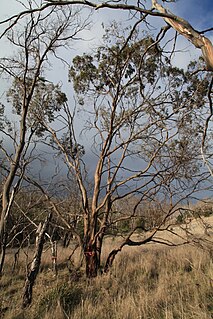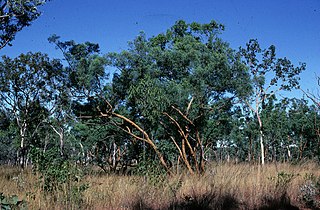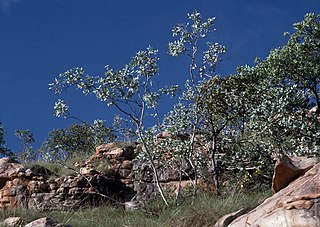
Eucalyptus morrisbyi, commonly known as Morrisby's gum, is a species of small to medium-sized tree that is endemic to a restricted area of Tasmania. It has loose slabs of rough bark near the base of its trunk, smooth pale grey bark above, lance-shaped to egg-shaped adult leaves, flower buds in groups of three, white flowers and barrel-shaped or cylindrical fruit. It is only known in the wild from a few small populations but has been widely planted as an ornamental.

Eucalyptus ovata, commonly known as swamp gum or black gum, is a small to medium-sized tree species that is endemic to south-eastern Australia. It has mostly smooth bark, glossy green, lance-shaped to egg-shaped adult leaves, green flower buds in groups of seven, white flowers and conical to bell-shaped fruit.

Eucalyptus miniata, commonly known as the Darwin woollybutt or woolewoorrng, is a species of medium-sized to tall tree that is endemic to northern Australia. It has rough, fibrous, brownish bark on the trunk, smooth greyish bark above. Adult leaves are lance-shaped, the flower buds are ribbed and arranged in groups of seven, the flowers orange or scarlet and the fruit is cylindrical to barrel-shaped or urn-shaped, with ribs along the sides.

Eucalyptus drummondii, commonly known as Drummond's gum or Drummond's mallee, is a species of mallee or tree that is endemic to the southwest of Western Australia. It has smooth bark, narrow elliptical to egg-shaped adult leaves, flower buds in groups of seven, white flowers and hemispherical fruit.

Eucalyptus alba, commonly known as white gum, khaki gum or poplar gum, is a species of tree that is native to Australia, Timor, and New Guinea. It has smooth bark, lance-shaped to egg-shaped leaves, flower buds in groups of seven, white flowers and conical to hemispherical fruits.

Eucalyptus apodophylla, commonly known as whitebark, is a small to medium-sized tree that is endemic to northern Australia. It has smooth, powdery white bark, broadly lance-shaped to egg-shaped adult leaves, flower buds in groups of seven, white flowers and hemispherical to conical fruit.

Eucalyptus brachyandra, commonly known as the tropical red box, is a straggly tree, mallee or shrub and is endemic to north-western Australia. It has rough, fibrous to stringy bark on the trunk and smooth grey to white bark on the smaller branches. Mature trees have elliptic to oblong or egg-shaped leaves, tiny flower buds in groups of three or seven, creamy white flowers and cup-shaped, bell-shaped or urn-shaped fruit. It grows in the Kimberley region of Western Australia and the Top End of the Northern Territory.

Eucalyptus houseana, commonly known as Kimberley white gum, or is a species of medium-sized tree that is endemic to the Kimberley region of Western Australia. It has smooth bark, lance-shaped adult leaves, flower buds in groups of seven, white flowers and conical to hemispherical fruit.
Eucalyptus kenneallyi, commonly known as Kenneally's white gum, is a species of tree that is endemic to two small islands off the Kimberley coast of Western Australia. It has smooth bark, lance-shaped adult leaves, flower buds in groups of seven, white flowers and cylindrical fruit.

Eucalyptus leucophloia, commonly known as snappy gum or migum, is a species of small tree or mallee that is endemic to northern Australia. The indigenous Mangarayi and Yangman peoples know the tree as mirndir, the Ngarluma name it as malygan and Yindjibarndi peoples know the tree as majgan. It has smooth, powdery bark, lance-shaped to egg-shaped adult leaves, flower buds usually in groups of seven, white flowers and cup-shaped, barrel-shaped or hemispherical fruit.

Eucalyptus lirata, commonly known as Kimberley yellowjacket, is a species of small tree or mallee that is endemic to the Kimberley region of Western Australia. It has rough, fibrous bark on the trunk and most of the branches, lance-shaped or curved adult leaves, flower buds arranged in groups of three, white flowers and cylindrical to cup-shaped fruit.

Eucalyptus mooreana, commonly known as Moore's gum, mountain white gum or King Leopold Range mallee, is a species of stunted, straggly tree or mallee that is endemic to the Kimberley region of Western Australia. It has smooth, powdery white bark, a crown of juvenile, sessile, stem-clasping leaves arranged in opposite pairs, flower buds arranged in groups of seven, white flowers and cup-shaped to hemispherical fruit.

Eucalyptus pantoleuca, commonly known as round-leaved gum or Panton River white gum, is a species of small tree that is endemic to the Kimberley region of Western Australia. It has smooth, powdery bark, more or less round adult leaves, flower buds in groups of three, white flowers and conical fruit that are glaucous at first.

Corymbia aspera, commonly known as the rough-leaved ghost gum, rough leaf range gum, desert bloodwood, Brittle Range gum in Western Australia, or snappy gum in the Northern Territory is a species of tree that is endemic to northern Australia. It has smooth white bark, sometimes with a short stocking of rough bark near the base, a crown of sessile juvenile, heart-shaped or egg-shaped leaves, flower buds in groups of seven, creamy white flowers and cup-shaped, barrel-shaped or cylindrical fruit.

Corymbia confertiflora, commonly known as the broad-leaved carbeen or the rough leaf cabbage gum, is a species of tree that is endemic to northern Australia. It has rough, tessellated bark near the base of the trunk, smooth white to pale grey bark above, a crown of both intermediate and adult leaves, large numbers of flower buds borne on leafless sections of branchlets in groups of seven, creamy white flowers and cylindrical to barrel-shaped or bell-shaped fruit.

Corymbia grandifolia, commonly known as the cabbage gum, large-leaved cabbage gum and the paper-fruited bloodwood, is a species of tree that is endemic to northern Australia. It has smooth bark, egg-shaped to broadly elliptic to lance-shaped adult leaves, flowers buds in groups of three or seven, creamy white flowers and cup-shaped to cylindrical fruit.

Eucalyptus ceracea also known as the Seppelt Range gum or Seppelt Range yellow-jacket, is a species of small tree or mallee that is endemic to a small area in the north of Western Australia. It has thick, fibrous or flaky bark on the trunk and larger branches, dull, glaucous, egg-shaped leaves arranged in opposite pairs, flower buds in groups of seven or nine, bright orange flowers and urn-shaped fruit. The leaves, buds and fruit are covered with a white wax.

Eucalyptus confluens, commonly known as Kimberley gum, is a species of small tree that is endemic to northern Australia. It has smooth, powdery white bark, lance-shaped adult leaves, more or less spherical flower buds in groups of seven, white flowers and cup-shaped to hemispherical fruit. It grows in the Kimberley region of Western Australia and in adjacent areas of the Northern Territory.

Eucalyptus neglecta, commonly known as Omeo gum, is a species of small tree that is endemic to a small area of Victoria, Australia. Older plants have rough, fibrous bark on the trunk, otherwise smooth grey to brownish bark, a crown of mostly lance-shaped, egg-shaped or oblong leaves arranged in opposite pairs, flower buds in groups of between seven and fifteen, white flowers and cup-shaped or conical fruit.
Eucalyptus pyrenea, commonly known as Pyrenees gum, is a species of tree that is endemic to Victoria, Australia. It has smooth, greyish bark with rough, fibrous bark on the lower part of the trunk, lance-shaped to curved adult leaves, flower buds in groups of seven, white flowers and cup-shaped fruit.

















